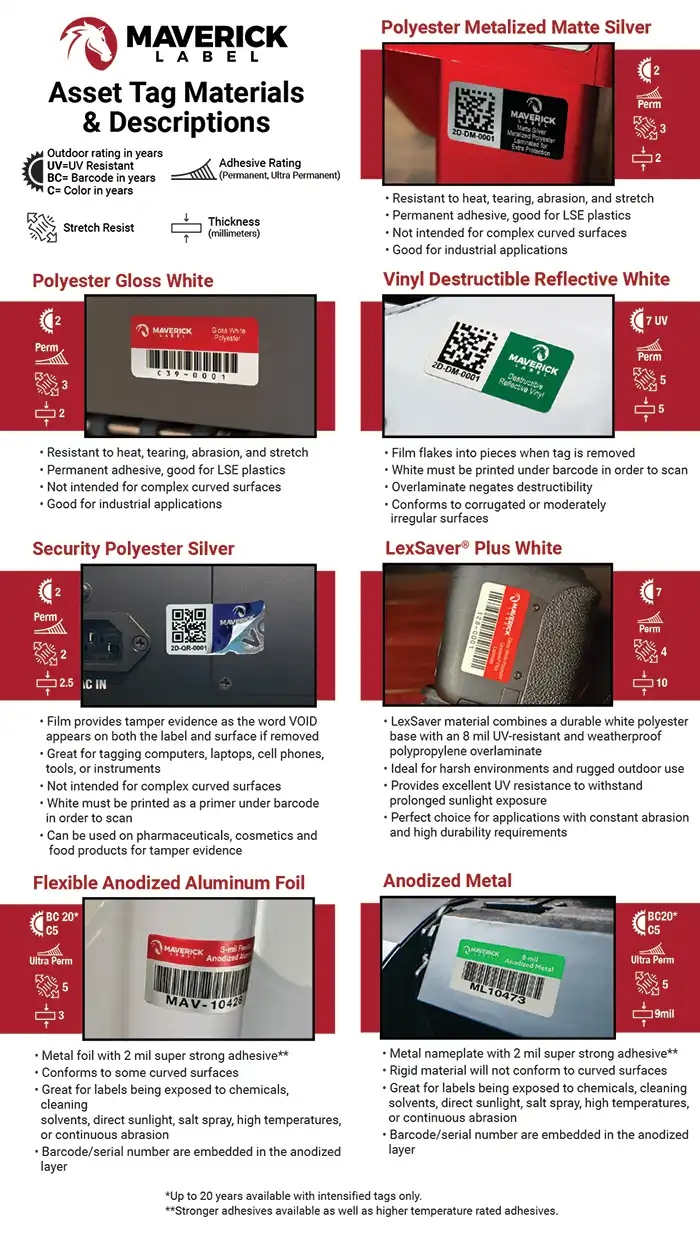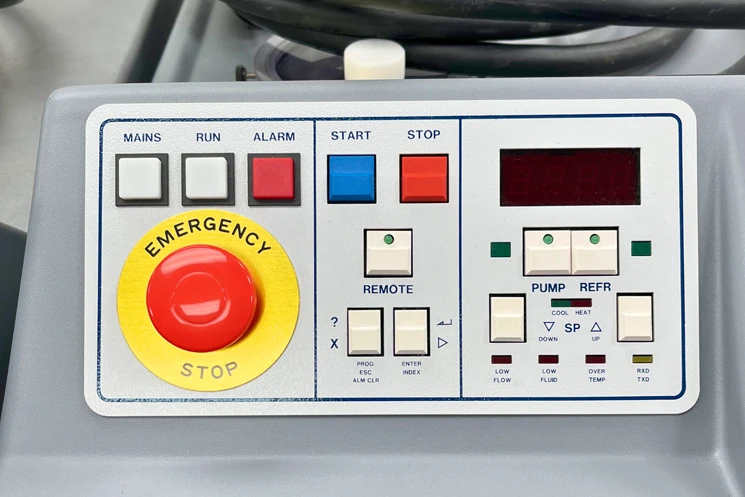The best materials for asset tags include anodized aluminum for rugged environments, polyester for general use, and vinyl for tamper-evident needs.
Each material has unique benefits, and the right choice depends on where and how you’ll use the tag. Choosing the right material can make asset tags more effective and long-lasting.
In this guide, we’ll explain the different materials available for asset tags, their uses, and which might work best for your needs.
Why Material Matters for Asset Tags
Choosing the right material is essential for asset tagging. The material affects how well tags stay in place, how long they last, and how readable they are over time. For example, if tags are exposed to high temperatures, chemicals, or rough handling, they need to be made of a material that can handle it.
Using the best material for each situation helps ensure that barcode labels, serial numbers, and RFID tags stay readable and durable. This makes asset tracking easier and helps companies manage physical assets and valuable equipment more effectively.

Types of Asset Tag Materials and Their Benefits
Here’s an overview of the best materials for asset tags and where each one works best.
1. Anodized Aluminum: Best for Tough Conditions
Anodized aluminum is one of the strongest options for asset tags. The anodizing process makes the tags highly resistant to abrasion, chemicals, and UV light. Text and serial numbers are embedded in the metal, making them last longer.
Benefits of Anodized Aluminum:
- Works well for asset tags for equipment in rough or outdoor settings
- Resists high temperatures and harsh conditions
- Long-lasting; ideal for maintenance and repair schedules that need reliable labeling
This material is commonly used for tagging machinery, outdoor equipment, and even laptops. If you need a tag that can handle extreme conditions, anodized aluminum is a top choice.
2. Polyester: Good for Indoor and Moderate Outdoor Use
Polyester asset tags are versatile and durable. They resist water, UV light, and moderate heat, which makes them a strong choice for both indoor and light outdoor use.
Benefits of Polyester:
- Resistant to tearing, water, and UV exposure
- Works well with barcode labels and RFID tags
- Great for tracking assets in offices, warehouses, and classrooms
Polyester tags are a good choice for IT equipment, laptops, and other high-value assets that need reliable labels indoors or in less extreme environments.
3. Security Polyester: For Tamper-Evident Tagging
Security polyester tags are designed to show signs of tampering. When someone tries to remove the tag, it leaves a “VOID” mark on the surface. These tags are often used on valuable or sensitive items.

Benefits of Security Polyester:
- Shows clear signs of tampering
- Suitable for industries like healthcare and IT
- Strong adhesive that sticks well to flat surfaces
These tags are ideal for laptop asset tags and other items that need visible protection from tampering.
4. Vinyl Destructible: Great for Short-Term Security
Vinyl destructible tags are made to break into small pieces if someone tries to remove them. This feature makes them perfect for short-term tamper-evident needs.
Benefits of Vinyl Destructible Tags:
- Provides high tamper resistance
- Breaks apart when tampered with
- Works well on slightly curved or uneven surfaces
Vinyl destructible tags are a good option for temporary tagging where you need strong tamper protection.
5. Flexible Anodized Aluminum Foil: For Curved Surfaces
Flexible anodized aluminum foil tags combine the durability of anodized aluminum with the flexibility to stick to curved surfaces. These tags handle high temperatures, chemicals, and abrasion well.
Benefits of Flexible Anodized Aluminum Foil:
- Conforms to curved surfaces like pipes or machinery
- Ideal for tough environments with chemicals and sunlight
- Long-lasting, suitable for harsh conditions
This material is great for tagging industrial tools and other equipment where both flexibility and durability are needed.
6. LexSaver® Plus: Best for Outdoor Use and UV Resistance
LexSaver® Plus tags have a polyester base with a UV-resistant overlaminate, making them perfect for outdoor use. They resist sunlight, moisture, and abrasion.
Benefits of LexSaver® Plus:
- Designed for long-term outdoor use
- Withstands UV exposure and weather conditions
- Suitable for real-time asset management system tracking
LexSaver® Plus tags are excellent for tagging equipment that will be outdoors or exposed to harsh weather.

Choosing the Best Material for Your Asset Tags
When selecting the best material for your asset tags, here are a few things to keep in mind:
- Environment – Will the tag be used indoors or outdoors? Will it face high temperatures, moisture, or chemicals?
- Durability Needs – Do you need a long-term tag or a temporary one? Materials like anodized aluminum are best for long-term durability.
- Adhesive Strength – A strong adhesive is essential to keep the tag in place. Tags like LexSaver® Plus and anodized aluminum have strong adhesives.
- Compatibility with Tracking Systems – Decide if you need barcode labels, RFID tags, or QR codes for scanning. These options make it easier to track items in real time and manage assets efficiently.
Best Material for Asset Tags FAQs
Polyester and anodized aluminum are both excellent options for laptop asset tags. Polyester is durable and cost-effective, while anodized aluminum offers extra protection against wear and tear.
Yes, certain materials like anodized aluminum, LexSaver® Plus, and UV-resistant polyester are designed for outdoor conditions. These materials resist moisture, sunlight, and temperature changes.
The benefit of asset tagging includes improved inventory management, easy identification, and the ability to monitor assets in real time. Tags with unique identifiers like barcodes and serial numbers make it simple to track assets across locations.
An asset tagging system assigns each item a unique ID, allowing it to be tracked within an asset management system. This improves accuracy in tracking assets, ensures up-to-date records, and helps plan maintenance and repair.
For high-value assets, tamper-evident options like security polyester or vinyl destructible are recommended. These tags show visible signs if tampered with, adding extra protection.
Final Thoughts
Choosing the best material for asset tags is essential for reliable asset tracking. From anodized aluminum to flexible foil and UV-resistant LexSaver®, each material brings unique benefits to your asset tagging process. Understanding your specific needs helps you choose tags that last, stay readable, and protect your assets over time.
A strong asset tagging system supports effective inventory management, real-time tracking, and consistent asset management.
Whether you’re managing equipment in tough conditions or valuable office assets, the right material choice will keep your tags secure and your tracking system running smoothly.



